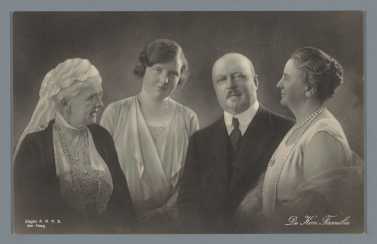
After the birth of Princess Juliana, Queen Wilhelmina would suffer two further miscarriages. Juliana would remain their only child and thus heiress to the throne. Juliana spent her childhood between three royal palaces: The Loo Palace in Apeldoorn, Noordeinde Palace and Huis ten Bosch in The Hague. A small classroom with three carefully selected students was formed at Noordeinde Palace so that she would receive her primary education with children her own age.
Wilhelmina loved showing off the young Princess during meetings with her ministers at the palace. In 1911, she wrote, “Our daughter grows like cabbage (fast) and is a lively, mobile, talkative child that notices, copies and asks endless questions.”1 Wilhelmina wanted, above all, to prevent the isolated childhood that she had had. Although Juliana would have a relatively happy family life, her parents drifted apart during the First World War. Henry was a loving father; he enjoyed playing games with her.
The war years would be a difficult time for all of them. Henry, a German prince by birth, was torn in his loyalties and as President of the Red Cross, he was away a lot. The Netherlands was neutral during the First World War, but Wilhelmina still conferred with her ministers nearly every day. At the end of the war, Henry, Wilhelmina and little Juliana were driven around the Malieveld in The Hague in a carriage in celebration. Around them, several monarchies had fallen, but the Netherlands still stood firm. Emperor Wilhelm II of Germany had fled to the Netherlands in early November, something Wilhelmina could not understand. Nevertheless, he would live out his days in the Netherlands. Henry and Juliana visited him and his second wife Hermine sometimes, though her mother never did.

During her youth, Juliana was raised by governesses and nurses. She loved animals and liked to play dress up like any other child. One particular dress-up party was immortalised in a painting with her father, mother and Juliana herself dressed in 17th-century dress. Juliana had to pose for nine hours, which she hated.
Juliana’s education as heir the throne would continue at a relentless pace. She would need to be ready to assume the throne at the age of 18 if it was necessary. At the age of 11, her primary education in the classroom ended. After this, she received a private education with several teachers. It was a lonely time for the young Princess, who desperately wanted siblings.
She was delighted to be allowed to attend university after her 18th birthday. Two days after her 18th birthday, her mother installed her in the Council of State and from now on she attended the Speech from the Throne in the Hall of Knights. She also received an allowance of 200,000 guilders a year, her own household and her own palace at Kneuterdijk. She would hardly ever use it. Juliana loved her university years and wanted nothing more than to be treated like any other person. She wanted real friends and made them too. Nevertheless, she was driven to classes from her villa in Katwijk, and a servant would always be waiting for her after classes. She was not allowed to take her final exams but did take three orals exams to end her studies with an honorary doctorate in 1930.
It was soon time to search for a husband for Juliana. Her mother and grandmother had both been 20 years old when they married, and Juliana was soon to be 21. Juliana herself did not consider it a priority to find a husband. She would continue to miss her university days and spent the following years in a lull.

She would suffer two losses in 1934 that would hit her hard. On 20 March, her grandmother Emma died. Just four months later, her father died. Juliana was in England with her relative Princess Alice, Countess of Athlone at the time of her father’s death. Juliana had the firm belief that death was simply the start of something else, and she wrote, “Mother carefully told me today that Father had died – I long to go to her. Although, after Grandmother’s death, death means nothing more to me than lovely things and I know Mother feels that as well. Father was very cheery this morning, and it happened in a second, not in her presence. Isn’t it lovely, so sudden. I am so glad to know that ever since Grandmother died, every life ends happily by ‘death.’ I am becoming a philosopher – don’t mind me.”2 He received a funeral in white to symbolise the transition to a new life.
Henry’s death also gave Juliana a new role – that of President of the Red Cross.
The search for a husband continued relentlessly. Queen Wilhelmina may have wanted a love match for her daughter, any future husband would still need to be a protestant, healthy, foreign – preferably of equal birth – royalty but he couldn’t be an heir to any throne. Wilhelmina used her Almanach de Gotha to seek out possible candidates. The rise of Hitler in Germany hindered the search as any German Prince following him was undoubtedly excluded.
By 1935, Wilhelmina was becoming desperate, but hope was nearby. Prince Bernhard of Lippe-Biesterfeld presented himself to Juliana in early 1936 during a ski-trip. He didn’t quite meet all the criteria – after the Second World War, it would become clear he had joined the Nazi-party – but he looked good on paper. For Juliana, it was love at first sight.

Be the first to comment